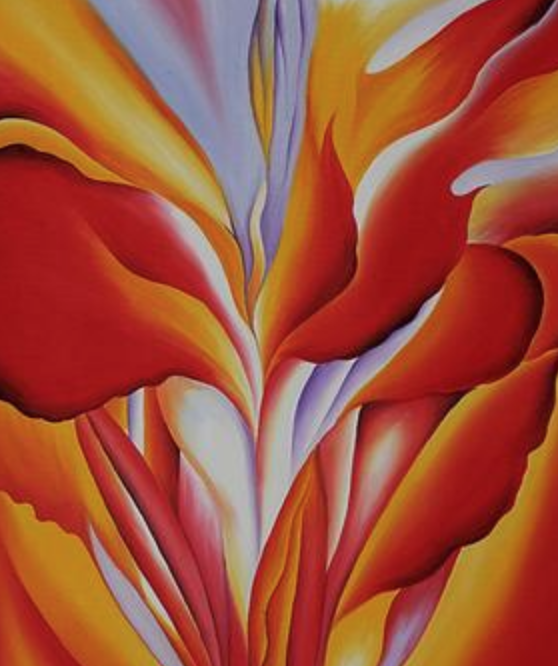Who ART You? 12
She is one of the best knownand recognizable artists in the world and I when I think of her, I think of flowers? But of course, she was famous for so much more! Know who she is? Let me introduce you to Georgia O’Keefe.
Who ART You?
Georgia O’Keefe November 15, 1887 – March 6, 1986
Harpers Bazarr wrote this about her. “A seminal figure of American Modernism, in 1915 Georgia O'Keeffe was one of the very first American artists to produce a purely abstract work of art, in contrast to the dominant movement of American realism. In Music, Pink and Blue from 1918, O'Keefe abstracts a floral subject with extreme cropping, producing an archway of colorful petals that hum with a musical energy suggested by the title. The theories of Russian artist Wassily Kandinsky in part inspired O'Keeffe to explore "the idea that music could be translated into something for the eye," to achieve pure expression free of other external references.”
From Wikipedia: Georgia Totto O'Keeffe was an American artist. She was best known for her paintings of enlarged flowers, New York skyscrapers, and New Mexico landscapes. O'Keeffe has been recognized as the "Mother of American modernism".
In 1905, O'Keeffe began her serious formal art training at the School of the Art Institute of Chicago and then the Art Students League of New York, but she felt constrained by her lessons that focused on recreating or copying what was in nature. In 1908, unable to fund further education, she worked for two years as a commercial illustrator, and then spent seven years between 1911 and 1918 teaching in Virginia, Texas, and South Carolina. During that time, she studied art during the summers between 1912 and 1914 and was introduced to the principles and philosophies of Arthur Wesley Dow, who espoused created works of art based upon personal style, design, and interpretation of subjects, rather than trying to copy or represent them. This caused a major change in the way she felt about and approached art, as seen in the beginning stages of her watercolors from her studies at the University of Virginia and more dramatically in the charcoal drawings that she produced in 1915 that led to total abstraction. Alfred Stieglitz, an art dealer and photographer, held an exhibit of her works in 1917. Over the next couple of years, she taught and continued her studies at the Teachers College, Columbia University in 1914 and 1915.
She moved to New York in 1918 at Stieglitz's request and began working seriously as an artist. They developed a professional relationship—he promoted and exhibited her works—and a personal relationship that led to their marriage in 1924. O'Keeffe created many forms of abstract art, including close-ups of flowers, such as the Red Canna paintings, that many found to represent women's genitalia, although O'Keeffe consistently denied that intention. The reputation of the portrayal of women's sexuality was also fueled by explicit and sensuous photographs that Stieglitz had taken and exhibited of O'Keeffe.
O'Keeffe and Stieglitz lived together in New York until 1929, when O'Keeffe began spending part of the year in the Southwest, which served as inspiration for her paintings of New Mexico landscapes and images of animal skulls, such as Cow's Skull: Red, White, and Blue and Ram's Head White Hollyhock and Little Hills. After Stieglitz's death, she lived permanently in New Mexico at Georgia O'Keeffe Home and Studio in Abiquiú, until the last years of her life when she lived in Santa Fe. In 2014, O'Keeffe's 1932 painting Jimson Weed sold for $44,405,000, more than three times the previous world auction record for any female artist. After her death, the Georgia O'Keeffe Museum was established in Santa Fe.
She began a series of watercolor paintings based upon the scenery and expansive views during her walks, including vibrant paintings she made of Palo Duro Canyon. O'Keeffe, who enjoyed sunrises and sunsets, developed a fondness for intense and nocturnal colors. Building upon a practice she began in South Carolina, O'Keeffe painted to express her most private sensations and feelings. Rather than sketching out a design before painting, she freely created designs. O'Keeffe continued to experiment until she believed she truly captured her feelings in the watercolor, Light Coming on the Plains No. I (1917) She "captured a monumental landscape in this simple configuration, fusing blue and green pigments in almost indistinct tonal graduations that simulate the pulsating effect of light on the horizon of the Texas Panhandle," according to author Sharyn Rohlfsen Udall.
Brought to you by www.janmccarthy.com
@janmccarthy
jan@janmccarthy.com
https://www.facebook.com/janmccarthystudio/
If you aren’t on my newsletter getting the lastest uptodate information, you may be missing out. Sign up here. Not only will I be offering some really rad online art workshops in the future that I know you will like, (say yes!), but I will be hosting a random drawing in the weeks to come! But only my subscribers to the newsletter, (not just the blog) will be eligble to win.
Follow me on IG ( @janmccarthy ) to get the lastest photo ops from my neighborhood (whichever one I happen to be in)

